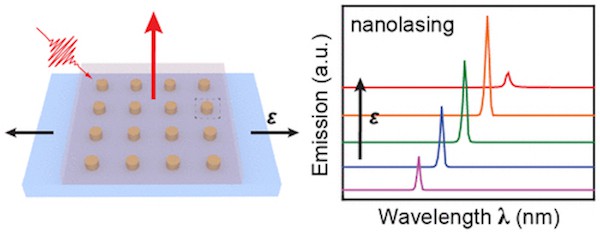
A new mechanically “stretchable” nanolaser based on gold nanoparticles patterned on an elastomeric slab surrounded by a liquid gain can lase at different light wavelengths. The new device, which is inspired by panther chameleons, might be used to make flexible, full-colour optical displays and multi-channel optical communications.
Researchers recently discovered that certain species of chameleon change the colour of their skin (from green to yellow, for example) by actively tuning a lattice of guanine nanocrystals within iridophore cells. These cells are nothing other than tuneable photonic crystals – nanostructured materials in which the periodic variation of the refractive index on the length scale of visible light produces a photonic band gap. This band gap affects how photons propagate through the material – just like a periodic potential in semiconductors affects the flow of electrons defining allowed and forbidden energy band gaps.
In photonic crystals, light of certain wavelength ranges can pass through the materials while light in other ranges is reflected. This allows the colour reflected by the crystals to be tuned by changing the band gap.
Going back to chameleons: in these animals, this gap is determined by the distance between the non-close-packed guanine nanocrystals, which can be adjusted by deforming the surrounding (elastic) skin. This allows for colour changes over the entire visible range of the electromagnetic spectrum.
Mechanically controlling laser colour
“Inspired by nature, we aimed to make a mechanochromic laser source that could also change colour via a similar mechanism,” explains Teri Odom of Northwestern University, who led this research effort. “To make such a device, in which we could mechanically control the laser colour, we exploited a lasing cavity based on a periodic array of nanoparticles in a stretchable, polymer (PDMS) matrix and liquid dye molecules surrounding the nanoparticles.”
The surface of the nanoparticles supports conduction electrons that oscillate collectively. These oscillations are known as surface plasmons, and in the case of the metal nanoparticle arrays are referred to as “lattice plasmons”. It is thanks to these plasmons, which when coupled with light, allows light to be compressed down to the nanoscale and focused to spots smaller than half its wavelength (the so-called diffraction limit).

Most plasmon-based lasers made to date have been difficult to tune easily because the optical gain was made from solid materials, like inorganic semiconductors or organic dyes in a solid matrix. The Northwestern researchers recently devised a way to overcome this problem by using a liquid gain material (made of liquid dye molecules) with the plasmonic nanocavity arrays.
There are many advantages in using liquid dye molecules,” explains Odom. “For one, we can dissolve them in different solvents with different refractive indices. This allows us to tune the dielectric environment around the nanoparticles, which also enables us to tune the lasing wavelength in real time. Liquid gain materials can be manipulated easily (in a microfluidic channel, for example), something that also allows us to tune the lasing emission by simply using liquids with different refractive indices.”
High-quality cavity modes
“In this new work, the large (around 260-nm-diameter) nanoparticles we used in our lattice (which has a spacing of 600 nm) produce high-quality cavity modes that tolerate uneven sample surfaces and defects, she adds. “The confined electromagnetic field in these cavity modes results in lasing action from regions close to the nanoparticles that support ‘hybrid quadrupole lattice plasmons’ and small changes in interparticle distance produce a change in the lasing wavelength. By thus stretching and releasing the elastomeric substrate, we can select the lasing emission colour at will.”
This is exactly the principle employed by our friends the chameleons to tune their skin colour, except that they use osmotic pressure to compress the photonic crystal lattice in their skin rather than stretching.
“The technology could find use in future flexible optical displays such as television and cell phone screens that require coherent light sources,” Odom tells Physics World. “Our system can be tuned from the ultraviolet to near-infrared by simply using different gain materials, which is promising for full-colour photonic displays ad multi-channel optical communications.”
Renmin Ma at the School of Physics at Peking University, who was not involved in this research, says that the study is “a significant step” towards making functional nanolasers. “The combination of dynamically changeable gain material and mechanically stretchable crystal lattice overcomes a major barrier to realizing high performance lasers with wide-range tunability.”
Törmä Päivi of Aalto University in Finland agrees: “The combination of stretchable substrate and multipolar nanoparticle resonances enables easy and robust mechanical control of the laser light colour,” she says. “This work will inspire us to think differently about applications of plasmonic nanoparticle arrays.”
The new stretchable nanolaser is detailed in Nano Letters 10.1021/acs.nanolett.8b01774.



